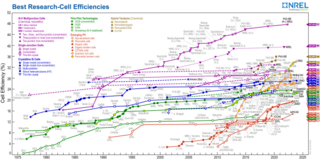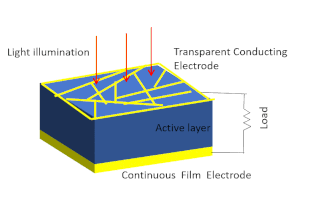
A solar-powered watch or light-powered watch is a watch that is powered entirely or partly by a solar cell.

A solar-powered watch or light-powered watch is a watch that is powered entirely or partly by a solar cell.
A model produced from 1978 by the Riehl Time Corporation was simply described as running on solar power, but having "silicon power cells" that "absorb energy from natural sunlight, daylight, or an ordinary light bulb". [1]
Some of the early solar watches of the 1970s had innovative and unique designs to accommodate the array of photovoltaic solar cells needed to power them (Synchronar, Nepro, Sicura and some models by Cristalonic, Alba, Rhythm, Seiko and Citizen). In 1996, Citizen started to sell analog light-powered watches under the Eco-Drive name. [2] Since their introduction, photovoltaic devices have greatly improved their efficiency and thereby their capacity. Watchmakers have developed their technology such that solar-powered watches had by 2009 become a major part of their range. [3] Several other watch manufacturers also use solar technology, such as Orient. [4] [5] [6] [7] [8] [9] Junghans, Casio, and Seiko. [10] [11]
Inexpensive solar-powered watches were first sold in the 1980s and were popular amongst children, often featuring famous fictional characters such as Transformers or G.I. Joe.[ citation needed ]

Typically, sunlight and artificial light are absorbed by a solar panel behind the crystal. The dial is either on a layer above or actually on the solar panel. This solar panel converts the light into electrical energy to power the watch. The watch will usually store energy in a rechargeable cell to power itself during the night or when covered such as a wearer's clothing (e.g., sleeve). Citizen's watches use lithium-ion batteries to store sufficient energy to power the watch for up to five years without light exposure, [3] by allowing the watch to enter a power-saving or hibernation mode during which the seconds hand stops until the watch is re-exposed to light. Not all have a power-save mode, yet will still hold a charge for typically six months, as with uncomplicated (date only) analog versions made by Citizen. [3]

Solar energy is radiant light and heat from the Sun that is harnessed using a range of technologies such as solar power to generate electricity, solar thermal energy, and solar architecture. It is an essential source of renewable energy, and its technologies are broadly characterized as either passive solar or active solar depending on how they capture and distribute solar energy or convert it into solar power. Active solar techniques include the use of photovoltaic systems, concentrated solar power, and solar water heating to harness the energy. Passive solar techniques include orienting a building to the Sun, selecting materials with favorable thermal mass or light-dispersing properties, and designing spaces that naturally circulate air.

A watch is a portable timepiece intended to be carried or worn by a person. It is designed to keep a consistent movement despite the motions caused by the person's activities. A wristwatch is designed to be worn around the wrist, attached by a watch strap or other type of bracelet, including metal bands, leather straps, or any other kind of bracelet. A pocket watch is designed for a person to carry in a pocket, often attached to a chain.

Orient is a Japanese watch manufacturer founded in 1950. Established as an independent company in 1950, it became a functional subsidiary of Epson in 2009 before being fully integrated into the company in 2017.

Photovoltaics (PV) is the conversion of light into electricity using semiconducting materials that exhibit the photovoltaic effect, a phenomenon studied in physics, photochemistry, and electrochemistry. The photovoltaic effect is commercially used for electricity generation and as photosensors.

Seiko Group Corporation, commonly known as Seiko, is a Japanese maker of watches, clocks, electronic devices, semiconductors, jewelry, and optical products. Founded in 1881 by Kintarō Hattori in Tokyo, Seiko introduced the world's first commercial quartz wristwatch in 1969.

Eco-Drive is a model range of watches manufactured and marketed worldwide by Citizen Watch Co., Ltd., powered primarily by light. As of 2007, the company estimated the drive system had eliminated the disposal of ten million batteries in North America.

Citizen Watch Co., Ltd. is an electronics company primarily known for its watches and is the core company of a Japanese global corporate group based in Nishitokyo, Tokyo, Japan. In addition to Citizen brand watches, it is the parent of American watch company Bulova, and is also known for manufacturing small electronic devices such as calculators.

A solar cell or photovoltaic cell is an electronic device that converts the energy of light directly into electricity by means of the photovoltaic effect. It is a form of photoelectric cell, a device whose electrical characteristics vary when it is exposed to light. Individual solar cell devices are often the electrical building blocks of photovoltaic modules, known colloquially as "solar panels". The common single-junction silicon solar cell can produce a maximum open-circuit voltage of approximately 0.5 to 0.6 volts.

A solar panel is a device that converts sunlight into electricity by using photovoltaic (PV) cells. PV cells are made of materials that produce excited electrons when exposed to light. The electrons flow through a circuit and produce direct current (DC) electricity, which can be used to power various devices or be stored in batteries. Solar panels are also known as solar cell panels, solar electric panels, or PV modules.
A solar tracker is a device that orients a payload toward the Sun. Payloads are usually solar panels, parabolic troughs, Fresnel reflectors, lenses, or the mirrors of a heliostat.
A photovoltaic system, also called a PV system or solar power system, is an electric power system designed to supply usable solar power by means of photovoltaics. It consists of an arrangement of several components, including solar panels to absorb and convert sunlight into electricity, a solar inverter to convert the output from direct to alternating current, as well as mounting, cabling, and other electrical accessories to set up a working system. It may also use a solar tracking system to improve the system's overall performance and include an integrated battery.
Nominal power is the nameplate capacity of photovoltaic (PV) devices, such as solar cells, modules and systems. It is determined by measuring the electric current and voltage in a circuit, while varying the resistance under precisely defined conditions. The nominal power is important for designing an installation in order to correctly dimension its cabling and converters.

A solar lamp, also known as a solar light or solar lantern, is a lighting system composed of an LED lamp, solar panels, battery, charge controller and there may also be an inverter. The lamp operates on electricity from batteries, charged through the use of a solar photovoltaic panel.

Solar architecture is an architectural approach that takes in account the Sun to harness clean and renewable solar power. It is related to the fields of optics, thermics, electronics and materials science. Both active and passive solar housing skills are involved in solar architecture.

Between 1992 and 2023, the worldwide usage of photovoltaics (PV) increased exponentially. During this period, it evolved from a niche market of small-scale applications to a mainstream electricity source. From 2016-2022 it has seen an annual capacity and production growth rate of around 26%- doubling approximately every three years.
Skyline Solar was a Concentrated Photovoltaic (CPV) company based in Mountain View, California. The company developed medium-concentration photovoltaic systems to produce electricity for commercial, industrial and utility scale solar markets. The company was founded in 2007 by Bob MacDonald, Bill Keating and Eric Johnson. The operation of the company appears to have ceased in late 2012 and the website is deactivated.

There are currently many research groups active in the field of photovoltaics in universities and research institutions around the world. This research can be categorized into three areas: making current technology solar cells cheaper and/or more efficient to effectively compete with other energy sources; developing new technologies based on new solar cell architectural designs; and developing new materials to serve as more efficient energy converters from light energy into electric current or light absorbers and charge carriers.

Solar-cell efficiency refers to the portion of energy in the form of sunlight that can be converted via photovoltaics into electricity by the solar cell.
The following outline is provided as an overview of and topical guide to solar energy:
There are many practical applications for solar panels or photovoltaics. From the fields of the agricultural industry as a power source for irrigation to its usage in remote health care facilities to refrigerate medical supplies. Other applications include power generation at various scales and attempts to integrate them into homes and public infrastructure. PV modules are used in photovoltaic systems and include a large variety of electrical devices.